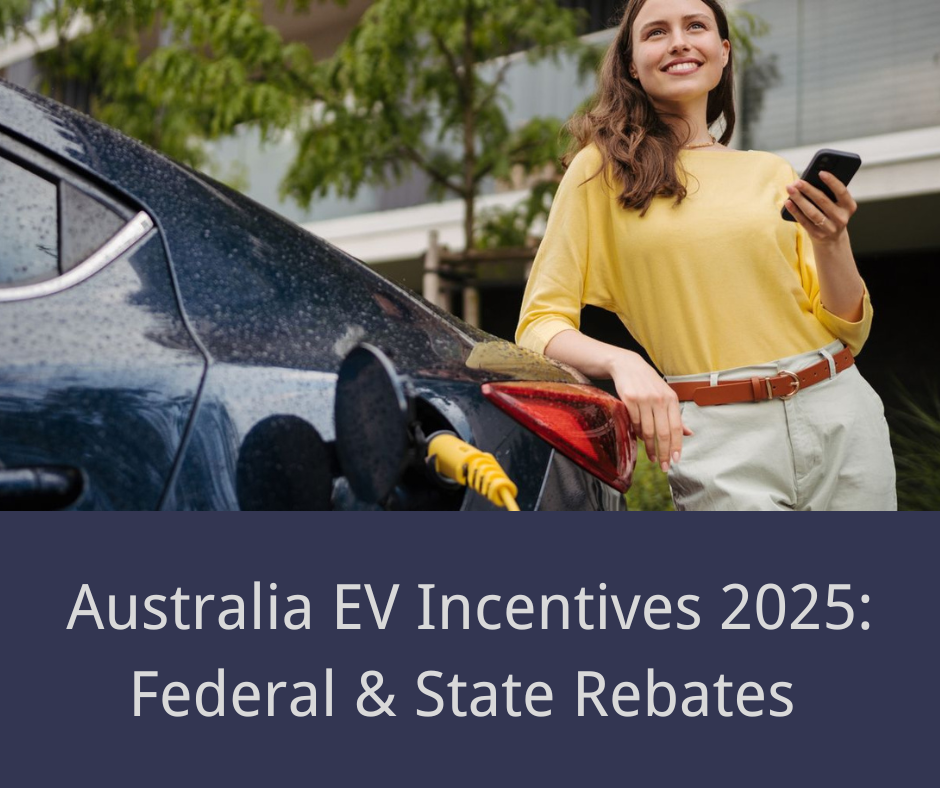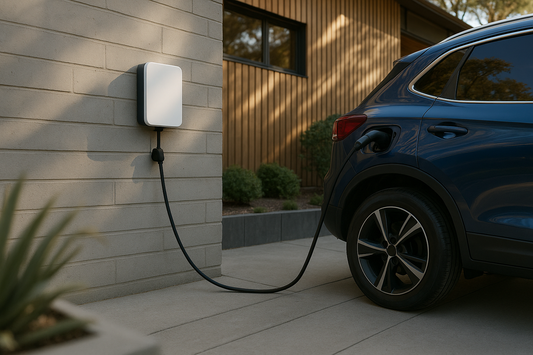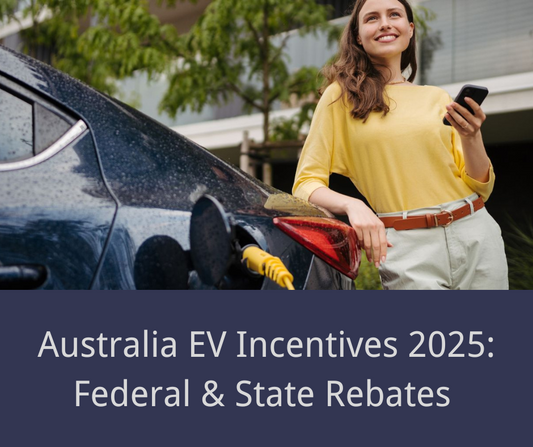The electric vehicle revolution is in full swing across Australia! More Aussies than ever are considering making the switch to cleaner, quieter, and often cheaper-to-run transportation. But navigating the landscape of government support – the rebates, exemptions, and concessions designed to make EVs more affordable – can feel overwhelming, especially as policies evolve.
If you're thinking about buying an electric car in 2025, you're in the right place. This guide is your comprehensive resource for understanding the Australian EV incentives available this year. We'll break down the crucial federal support and dive deep into the specific electric vehicle rebates Australia 2025 offers on a state-by-state basis, helping you maximise your savings.
Federal Focus: Understanding the 2025 Electric Car FBT Exemption
One of the most significant financial benefits available Australia-wide comes from the federal government's Fringe Benefits Tax (FBT) exemption for eligible electric cars.

What is it? If an employer provides an eligible electric car to an employee for private use, the employer generally doesn't have to pay FBT on that benefit.
Who benefits most? This primarily advantages:
- Employees using a novated lease EV Australia arrangement through their employer.
- Businesses providing company cars to employees. The savings can be substantial, potentially making an EV cheaper through these arrangements than buying outright with cash.
Eligibility for Battery Electric Vehicles (BEVs):
- The BEV must have been first held and used on or after July 1, 2022.
- The value of the car at the first retail sale must be below the Luxury Car Tax (LCT) threshold for fuel-efficient vehicles. For the 2024/25 financial year, this threshold is $91,387 (Note: this figure can be indexed and may change for the 2025/26 financial year).
- Both new and used BEVs can be eligible if they meet the criteria.
CRITICAL UPDATE: PHEV FBT Exemption Ends April 1, 2025!

This is a major change for 2025 that potential Plug-in Hybrid Electric Vehicle (PHEV) users need to be aware of.
- From April 1, 2025, PHEVs will no longer be considered low-emission vehicles for FBT exemption purposes.
- Grandfathering: The only exception is if you have a "financially binding commitment" that was already in place before April 1, 2025, to continue providing that specific PHEV. Any changes to that agreement after this date (like refinancing or extending the lease term beyond the initial binding period) will likely end the exemption.
Given today's date (March 30, 2025), this deadline is imminent. If you are considering a PHEV via salary sacrifice or as a company car, you must confirm the FBT implications based on your specific arrangement's start date and binding nature.
- Find out more from the official source: Australian Taxation Office (ATO) - Electric Cars Exemption Information and FBT on Plug-in Hybrid Vehicles
State-by-State Guide: 2025 EV Incentives & Rebates Across Australia
Beyond the federal FBT exemption, incentives vary significantly depending on where you live. Some states offer generous rebates or concessions, while others have phased out major programs.

Here's a quick comparison table, followed by a detailed breakdown for each state and territory.
| State/Territory | Primary Consumer Incentive(s) 2025 | Key Eligibility / Notes | Status (as of early 2025) |
|---|---|---|---|
| ACT | Stamp Duty Exemption, Potential 2yrs Free Rego, Loans | New/Used ZEVs (Stamp Duty), New ZEVs (Rego - verify), $15k loan (check eligibility) | Active |
| NSW | Fleet Incentives Only | Consumer rebates/stamp duty ended Dec 2023. Fleet boost Nov 24 - Jun 25. | Consumer Ended; Fleet Active |
| NT | Stamp Duty Concession (up to $1.5k), Rego Fee Waiver | BEV/PHEV <$50k (Stamp Duty - until June 2027), Rego details vary. | Active |
| QLD | $6,000 Rebate | New ZEV <$68k dutiable value, Household Income <$180k. | Active (Verify end date) |
| SA | 3 Years Free Registration | New BEV/FCEV <$68.75k. $3k Rebate potentially available (verify status). | Active (Rego); Rebate (Verify) |
| TAS | $2,000 Rebate | Check specific eligibility criteria & end date. | Active (Verify status/end date) |
| VIC | Limited / None | Major $3k rebate ended 2023. Check for minor concessions. | Major Programs Ended |
| WA | $3,500 Rebate | New ZEV <$70k (verify cap). Ends May 10, 2025 or when 10k rebates claimed. | Active (Time/Cap Limited) |
Australian Capital Territory (ACT) EV Incentives 2025 The ACT continues to be a leader in supporting EV uptake.
- Stamp Duty Exemption: No stamp duty payable on new or used Zero Emission Vehicles (ZEVs - includes BEVs and Fuel Cell Electric Vehicles FCEVs).
- Registration: Potentially 2 years of free registration for new ZEVs (verify current offer specifics).
- Sustainable Household Scheme: Access to interest-free loans of up to $15,000 may be available for EVs and related charging infrastructure (check scheme eligibility).
- Find out more: ACT Revenue Office - Vehicle Duty Information & ACT Government - Sustainable Household Scheme
New South Wales (NSW) EV Incentives 2025 NSW has shifted its focus away from direct consumer purchase incentives.
- Consumer Rebates/Stamp Duty: The $3,000 rebate and stamp duty waivers for consumers ended on December 31, 2023.
- Fleet Incentives: The government is encouraging businesses to transition with the NSW EV fleet incentive, which received boosted funding between November 2024 and June 2025.
- Find out more (Fleet): NSW Climate and Energy Action - Electric Vehicle Fleets Incentive
Northern Territory (NT) EV Incentives 2025 The NT offers long-term concessions to encourage EV adoption.
- Stamp Duty Concession: A saving of up to $1,500 on stamp duty for new and used BEVs and PHEVs valued up to $50,000. This is available until June 30, 2027.
- Registration Fee Waiver: Reduced registration fees or waivers may apply for EVs.
- Find out more: NT Government - Motor Vehicle Registry Fees & Concessions (Check for EV specifics)
Queensland (QLD) EV Incentives 2025 Queensland currently offers one of the most generous direct rebates.
- $6,000 EV Rebate: Available for new ZEVs with a dutiable value of $68,000 or less.
- Eligibility: Applicants must have a total annual household taxable income of $180,000 or less.
- Find out more and apply: QLD Government - Zero Emission Vehicle Rebate Scheme (Verify current status and closing date)
South Australia (SA) EV Incentives 2025 SA offers registration relief and potentially a rebate.
- 3 Years Free Registration: Available for new BEVs and FCEVs valued up to $68,750 (incl. GST).
- $3,000 Rebate: Previous rounds existed; verify the current status and availability of this $3,000 rebate for new eligible vehicles.
- Find out more: SA Government - Electric Vehicle Information & Rebates (Check for rebate status and registration details)
Tasmania (TAS) EV Incentives 2025 Tasmania has offered rebates previously, but status needs checking.
- $2,000 Rebate: A rebate of this amount has been available. Verify the current status, eligibility criteria, and end date for this program. Check for any stamp duty or registration concessions.
- Find out more: TAS Government - Renewables, Climate and Future Industries Tasmania (ReCFIT) - Electric Vehicles Section (Check for current incentives)
H3: Victoria (VIC) EV Incentives 2025 Victoria's main consumer subsidy program has concluded.
- Rebate Ended: The $3,000 ZEV Subsidy program ended in mid-2023.
- Other Concessions: Check for any minor remaining benefits like potential registration discounts, but major purchase incentives are no longer active for consumers.
- Find out more: VIC Government - Solar Victoria (Previous Administrator) or VicRoads - Registration Information (Check for any current ZEV concessions)
Western Australia (WA) EV Incentives 2025 WA offers a rebate, but time is running out!
- $3,500 Rebate: Available for new ZEVs with a dutiable value up to $70,000 (verify current cap).
- KEY DEADLINE: This rebate is limited to the first 10,000 eligible vehicles OR ends on May 10, 2025, whichever occurs first. Act fast if you're considering this!
- Find out more and apply: WA Department of Transport - Zero Emission Vehicle (ZEV) Rebate
Don't Miss Out: Understanding Eligibility & Application Steps

Navigating the details is crucial to ensuring you receive the benefits you're entitled to.
- Vehicle Price Caps: Pay close attention! The federal FBT exemption relies on the LCT threshold, while state rebates/waivers have their own specific dutiable value caps (e.g., $68k in QLD, $70k in WA - verify!).
- Eligibility Nuances: Check if incentives apply to new EVs only, or used EVs as well (like the ACT stamp duty). Residency in the specific state/territory is always required. Vehicle type (BEV, PHEV, FCEV) matters depending on the incentive.
- Application Process: This varies. Some incentives are applied at the point of sale (like stamp duty waivers), while rebates usually require an application after purchase with proof (contract, registration, license, sometimes income verification).
- Stacking Incentives: Generally, you can combine the federal FBT exemption (if applicable via novated lease/company car) with relevant state-level incentives like rebates or registration discounts.
Crucially: Always visit the official government websites linked above for the most current information, full eligibility criteria, and application forms before making any commitments.
Driving into 2025: Your Next Steps for EV Savings
Australia's EV incentive landscape in 2025 presents a mixed but still valuable picture. While some major state rebates have ended (NSW, VIC), significant federal support via the FBT exemption (especially for BEVs) remains a key driver, alongside strong state programs in Queensland, Western Australia (act fast!), ACT, NT, and SA. Remember the critical PHEV FBT changes 2025 if considering a plug-in hybrid.
Taking the time to understand the Australian EV incentives relevant to your situation and location can save you thousands of dollars on your transition to electric driving.

Your next steps:
- Identify the federal and state incentives you might be eligible for based on this guide.
- Visit the official government websites linked above to verify details and application procedures.
- Factor these potential savings into your budget when comparing EV models.
Ready to make the switch? Share this 2025 EV incentives guide with friends, family, or colleagues also considering an electric future!



